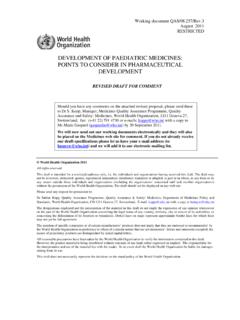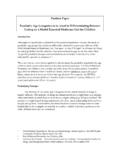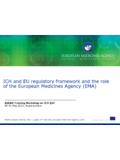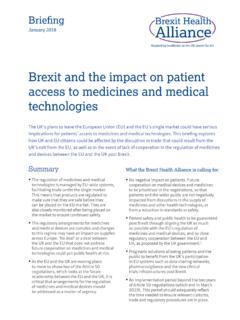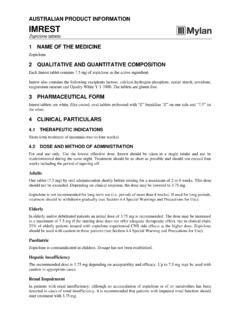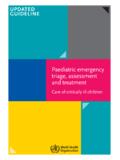Transcription of DEVELOPMENT OF PAEDIATRIC MEDICINES: …
1 Working document February 2008 RESTRICTED DEVELOPMENT OF PAEDIATRIC MEDICINES: pharmaceutical DEVELOPMENT . points TO CONSIDER At the forty-second meeting of the WHO Expert Committee on Specifications for pharmaceutical Preparations held on 15-19 October 2007, a draft on DEVELOPMENT of PAEDIATRIC Medicines: points to Consider (update of the version dated 14 May 2007) was discussed with a view to contributing to the pharmaceutical part of the document.
2 This paper has been prepared by Professor Henning G. Kristensen, Denmark, and presents a first draft on pharmaceutical DEVELOPMENT of PAEDIATRIC medicines. It is based on the above-mentioned paper and the European Medicines Agency (EMEA) Reflection Paper: Formulations of Choice for the PAEDIATRIC population (2006). A points to consider document should not detail instructions for the DEVELOPMENT but should rather make references to relevant literature. Some of the matters dealt with in the draft on DEVELOPMENT of PAEDIATRIC medicines have, therefore, been omitted in this proposal. Please address comments on this proposal, by 13 May 2008, to Dr S. Kopp, Quality Assurance and Safety: Medicines, Medicines Policy and Standards, World Health Organization, 1211 Geneva 27, Switzerland, fax: (+41 22) 791 4730 or e-mail: with a copy to.
3 World Health Organization 2008 All rights reserved. This draft is intended for a restricted audience only, the individuals and organizations having received this draft. The draft may not be reviewed, abstracted, quoted, reproduced, transmitted, distributed, translated or adapted, in part or in whole, in any form or by any means outside these individuals and organizations (including the organizations' concerned staff and member organizations) without the permission of the World Health Organization. The draft should not be displayed on any web site. Please send any request for permission to: Dr Sabine Kopp, Quality Assurance Programme, Quality Assurance & Safety: Medicines, Department of Medicines Policy and Standards, World Health Organization, CH-1211 Geneva 27, Switzerland. Fax: (41-22) 791 4730; e-mail: with a copy to The designations employed and the presentation of the material in this draft do not imply the expression of any opinion whatsoever on the part of the World Health Organization concerning the legal status of any country, territory, city or area or of its authorities, or concerning the delimitation of its frontiers or boundaries.
4 Dotted lines on maps represent approximate border lines for which there may not yet be full agreement. The mention of specific companies or of certain manufacturers products does not imply that they are endorsed or recommended by the World Health Organization in preference to others of a similar nature that are not mentioned. Errors and omissions excepted, the names of proprietary products are distinguished by initial capital letters. All reasonable precautions have been taken by the World Health Organization to verify the information contained in this draft. However, the printed material is being distributed without warranty of any kind, either expressed or implied. The responsibility for the interpretation and use of the material lies with the reader. In no event shall the World Health Organization be liable for damages arising from its use.
5 This draft does not necessarily represent the decisions or the stated policy of the World Health Organization. Working document page 2 SCHEDULE FOR THE PROPOSED ADOPTION PROCESS OF DOCUMENT : DEVELOPMENT OF PAEDIATRIC MEDICINES: pharmaceutical DEVELOPMENT . points TO CONSIDER First draft points for consideration prepared by Dr Susan Walters, Australia 14 May 2007 Further extended revision of the part on pharmaceutical DEVELOPMENT as a stand-alone text February 2008 Circulation of document for comments as well as posting on Expert Committee and Prequalification web sites March-April 2008 Consolidation of comments and review in informal consultation May-June 2008 Circulation of revised draft for comments July 2008 Presentation to the forty-third WHO Expert Committee on Specifications for pharmaceutical Preparations 13-17 October 2008 Working document page 3 CONTENTS page 1.
6 INTRODUCTION .. 4 2. AGE CATEGORIES IN PAEDIATRIC POPULATIONS .. 4 3. DOSAGE FORMS OF CHOICE .. 5 4. ACTIVE pharmaceutical INGREDIENTS .. 7 Purity of APIs .. 9 Aqueous solubility .. 9 Stability aspects .. 10 Microbial purity .. 10 5. EXCIPIENTS .. 10 Choice of excipients .. 11 Safety aspects .. 12 Taste masking of oral liquids .. 14 Colouring agents .. 15 6. pharmaceutical DEVELOPMENT .. 15 Design of dosage forms .. 17 Dissolution testing .. 18 7. ORAL ADMINISTRATION .. 18 Biopharmaceutical parameters .. 19 Liquid oral dosage forms .. 19 Solid oral dosage forms .. 21 8. RECTAL ADMINISTRATION.
7 22 9. INJECTABLES .. 24 10. REFERENCES .. 25 Working document page 4 1. INTRODUCTION Safe and effective pharmacotherapy in PAEDIATRIC patients requires the timely DEVELOPMENT of information on the proper use of medicines in PAEDIATRIC patients of various ages. Formulations developed specifically for the PAEDIATRIC population are often needed. The use of unlicensed and off-label medicines in children is, however, widespread. According to some authorities, more than 60% of all medicines used in children have not been tested in or authorized for the PAEDIATRIC population. Such testing as has been conducted in adults may have been for a different indication. Adult dosage forms may not be suitable for use in younger children because their physiology, metabolism, pharmacokinetics and pharmacodynamics may be quite different from those of adults.
8 This lack of information and frequently a lack of appropriate dosage forms may expose children to overdosing and unwanted side-effects, or underdosing without the expected efficacy. A separate issue is that of extemporaneous preparation of medicines from starting materials or adult medicines. Pharmacists are often faced with the need to extemporaneously manipulate adult medicines or active pharmaceutical ingredients (APIs) to provide medicines for PAEDIATRIC use. The practise is hazardous, both for the patient in terms of product stability, bioavailability and accurate dosing, and for the dispenser who may face ethical and legal consequences in the event of a poor outcome when the product is administered. Whilst recommending against off-label manipulation whenever possible, this paper provides guidance for situations where there are no other options.
9 In pharmacology and clinical paediatrics the focus is on the API when determining the dosage, clinical effects and adverse drug reactions. The formulation of PAEDIATRIC medicines is also important since the choice of dosage form and its formulation determine, in practice, whether the dose can be successfully delivered to the patient. This paper is intended to provide guidance on the formulation of PAEDIATRIC medicines to be prepared extemporaneously or intended for a marketing authorization. The guidance focuses on suitable dosage forms for children of different ages, formulation excipients and some specific dosage forms. 2. AGE CATEGORIES IN PAEDIATRIC POPULATIONS This paper uses the following age groups in relation to developmental stages: pre-term newborn infants/"premature" (< 37 weeks gestation); full-term newborn infants/"neonates" (0-28 days); infants and toddlers (1 month to 2 years); children, pre-school (2-5 years); children, school (6-11 years); and adolescents (12 years to legal age of consent (16 or 18 years dependent on the region)).
10 The age categories adopted by the International Conference on Harmonisation (ICH) (ICH E11, Clinical Investigation of medicinal products in the PAEDIATRIC population) combine children from 2 to 11 years into one group. For the present purpose it is appropriate to subdivide this group into two: pre-school (2-5 years) and school (6-11 years), because of the differences in the children's ability to accept and use different dosage forms (see table ). Working document page 5 PAEDIATRIC medicines must allow accurate administration of the dose to children of varying age and weight and, at the same time, the formulation and the manner in which they are administered must be acceptable the child and the care-giving adult.










